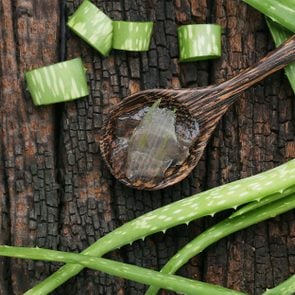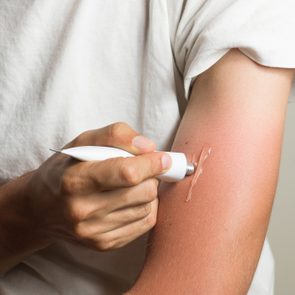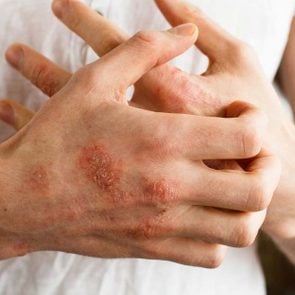9 Reasons to Try an Oatmeal Bath
Updated: Nov. 23, 2021
The secret to softer skin may be sitting in your pantry. Here's why dermatologists say oatmeal baths are great for your skin.
Oatmeal as skincare
Oats are having a moment. The staple pantry item is popping up in all sorts of products, from plant-based milk and cheese to gluten-free baked goods—and of course, inspiring endless flavor combinations of overnight oats.
However, long before we started adding oat milk to our lattes, oatmeal served as a star skin-care ingredient. Medical literature from ancient Egypt and Rome describes how ground-up oats were used to effectively treat dry, itchy skin, according to an article published in the Journal of Drugs in Dermatology.
Modern research backs up many of these early claims. But that doesn’t mean you should start slathering up with your instant breakfast. Studies show the grain’s health benefits for skin come from the grain’s colloidal form.
What is colloidal oatmeal?
Colloidal oatmeal is essentially oats ground into a fine powder that can dissolve in water, says Lucy Chen, MD, a board-certified dermatologist at Riverchase Dermatology in Miami.
This mixture creates a salve-like liquid that’s easy to apply and quickly absorbed by the skin, she explains.
It’s also an active ingredient regulated by the U.S. Food and Drug Administration (FDA). In 2003, the FDA approved colloidal oatmeal as a skin protectant that effectively relieves itching and irritation caused by a range of dermatological conditions.
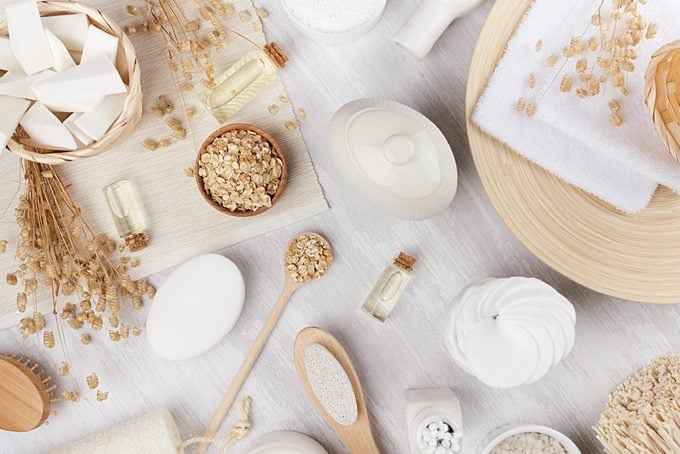
What is an oatmeal bath?
Today, you can find colloidal oatmeal as an active ingredient in products like creams, lotions, soaps, and shampoos.
But an easy, inexpensive way to soak in the grain’s soothing skin benefits is by adding it to a bath, says Debra Jaliman, MD, a board-certified dermatologist based in New York City.
“The baths are best because they [also] hydrate the skin while providing contact with the oatmeal,” says Tanya Kormeili, MD, a board-certified dermatologist in Santa Monica, California.
She adds that some products containing colloidal oatmeal, such as masks, can include allergens or other irritating ingredients, which may worsen dry skin and exacerbate conditions like eczema.
Oatmeal bath benefits
The ancient Egyptians were on to something. Today’s research shows that bathing in colloidal oatmeal:
Strengthens your skin barrier
“The outermost layer of the skin is called the stratum corneum,” says Madeline Gainers, MD, a board-certified dermatologist in Maryland. “It serves as a very important barrier.”
This layer keeps out unhealthy, dangerous toxins from the environment as well as fungi, bacteria, and other pathogens.
“It also holds water in, which is essential to prevent dehydration,” she explains.
Dr. Gainers says colloidal oatmeal has a variety of components that contribute to this skin barrier, such as polysaccharides and hydrocolloids.
These particles bind water to the skin—and when dissolved into a colloidal solution, they evenly distribute as a thin film. This creates a barrier that prevents water loss, keeping the skin hydrated.
Moisturizes dry skin
Oatmeal’s water-binding effect doesn’t just keep the skin barrier strong. It helps combat dry skin, too.
A study published in Clinical, Cosmetic and Investigational Dermatology found that oatmeal significantly moisturized people’s dry skin—and the results lasted for two weeks following treatment.
Other research published in the same journal suggests the lipids in oats may stimulate the production of ceramides, a fatty, naturally occurring substance in the skin that works to lock in moisture.
Balances your skin’s pH
Healthy skin has a slightly acidic pH level.
According to a study published in the International Journal of Cosmetic Science, this acidity helps keep skin healthy by fighting infection and other damaging substances, like free radicals. An optimal pH also promotes better skin-barrier function and more moisturized skin.
But everything from soap to cosmetics, air pollution, and sun exposure can disrupt your skin’s pH balance, which can lead to a weaker skin barrier and skin irritation.
Yet, the Clinical, Cosmetic and Investigational Dermatology research suggests ingredients in oatmeal—particularly saponins—act as a buffer system, restoring the skin’s normal pH.
Soothes psoriasis
Psoriasis is an autoimmune condition that causes skin to regenerate too quickly. This rapid turnover leads to a buildup of dead skin cells—often in patches that become inflamed, itchy, and painful.
It’s unclear what triggers psoriasis, and there’s currently no cure. But studies show that colloidal oatmeal is one treatment that helps people manage the chronic condition.
This is thanks to the oats’ avenanthramides, Dr. Gainers says, which are potent antioxidants with strong anti-inflammatory properties. According to research published in the Journal of Drugs in Dermatology, these micronutrients may even block skin cells from releasing chemicals that lead to inflammation.
Can take the sting out of eczema
The Clinical, Cosmetic and Investigational Dermatology study concluded that colloidal oatmeal’s properties could help ease the symptoms of eczema as well.
According to the American Academy of Dermatology (AAD), this common skin condition (also called atopic dermatitis) is likely caused by an immune system sensitivity—and it also usually runs in families. Eczema triggers someone’s immune system to overreact to everyday irritants like detergent, pollen, or pollution, resulting in “flare-ups” of dry, itchy skin.
In the study, a colloidal oatmeal treatment led to significantly less severe symptoms in people with chronic eczema on their hands.
Eases itchy skin and rashes
Oatmeal’s moisturizing, anti-inflammatory, and itch-soothing properties tackle even more skin issues.
Along with soothing the symptoms of chronic conditions like eczema and psoriasis, Dr. Jaliman says oatmeal can help relieve allergic reactions on the skin.
A study from the Journal of Drugs in Dermatology found evidence that the avenanthramides in oatmeal may also have an antihistamine effect. That means it can help relieve allergy-induced rashes or hives caused by medications, plants like poison ivy, and bug bites.
These benefits extend to non-allergic skin irritation as well—like the itching and inflammation caused by chickenpox, shingles, and sunburn.
May protect against UV damage
The antioxidants in oatmeal are strong ultraviolet (UV) light absorbers, according to the research in the Journal of Drugs in Dermatology.
While that doesn’t make oatmeal a replacement for protective sunscreen, this antioxidant activity may help strengthen the skin barrier against the sun’s damaging rays.
Cleans your skin
Oatmeal also acts as a mild skin cleanser. This is thanks to the grain’s saponins, plant-based compounds with soap-like properties that gently wash away dirt and oil—without drying out your skin.
Oatmeal’s antibacterial and anti-inflammatory properties make it great for cleansing and calming acne-prone skin as well. This is especially true if you’re using harsh acne treatments that can irritate your skin barrier.
Helps you relax
While a colloidal oatmeal soak can soothe and strengthen your skin, research shows simply taking a bath can have health benefits, too.
A study published in Evidence-Based Complementary and Alternative Medicine found that bathing calms our nervous system, promoting stress relief. And bathing before bed can also help us fall asleep faster and stay asleep longer, according to another study from Sleep Medicine Reviews.
How do you make an oatmeal bath?
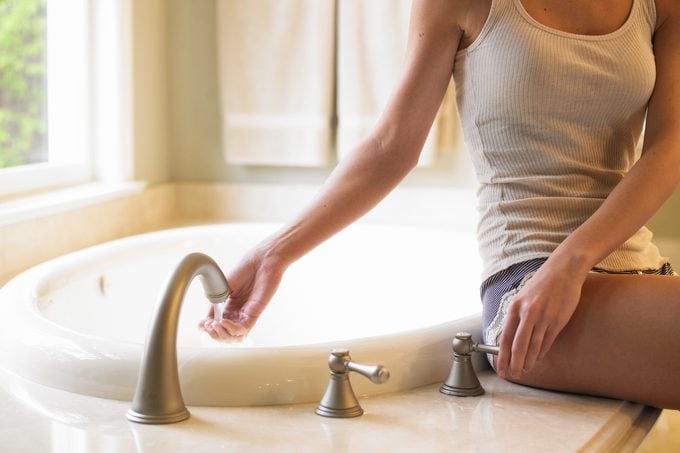
Dr. Chen says you can use any oats to make an oatmeal bath—so long as they’re in a colloidal form. That means you’ll need to grind your oatmeal into a very fine powder so it can evenly disperse in the bath, giving it a milky look.
You can also buy pre-made colloidal oats to toss in the tub. Just make sure to look out for added ingredients that may irritate your skin.
Once you have your colloidal oatmeal:
- Make sure your bath is lukewarm—steaming hot water will irritate your skin.
- Add about one cup of the finely powdered oats to the water.
- Soak for about 10 to 15 minutes.
Soaking too long can actually do more harm than good, Dr. Chen explains.
“This could do the opposite of what [the oatmeal bath] is meant to do, drying out your skin and aggravating any skin condition.”
After bathing, you can pat your skin with a clean towel—but Dr. Kormeili says to apply a thick, alcohol-free moisturizer while your skin is still a bit damp. This works to seal in the moisture from the bath.
Are oatmeal baths safe for everyone?
The Clinical, Cosmetic and Investigational Dermatology study found that colloidal oatmeal is a skin-safe treatment with low potential for causing irritation or an allergic reaction.
That said, some people have an allergy to avenin, a protein found in oats.
To ensure an oatmeal bath is safe for you or your child, try a patch test before hopping in the tub:
- Dissolve a bit of colloidal oatmeal in water.
- Apply to a small area of your skin.
- Rinse the oatmeal off after 10 to 15 minutes.
- Look for signs of irritation, like itching, redness, or inflammation.
Oatmeal bath alternatives
Other kitchen staples contain ingredients with similar anti-inflammatory properties that can help your skin feel refreshed, Dr. Chen says, like Epsom salt, baking soda, and apple cider vinegar.
“Another option to use is green tea,” Dr. Jaliman adds. When the tea is cooled and used as a compress, it also acts as an anti-inflammatory.
No matter what you add to your tub, your post-bathing routine is just as important, Dr. Kormeili explains.
“I find that patients who use natural oils—like coconut, avocado, or olive oil—immediately after water contact do well with their dry and eczema-prone skin,” she says. “Sealing in moisture is very key for dry skin.”

















